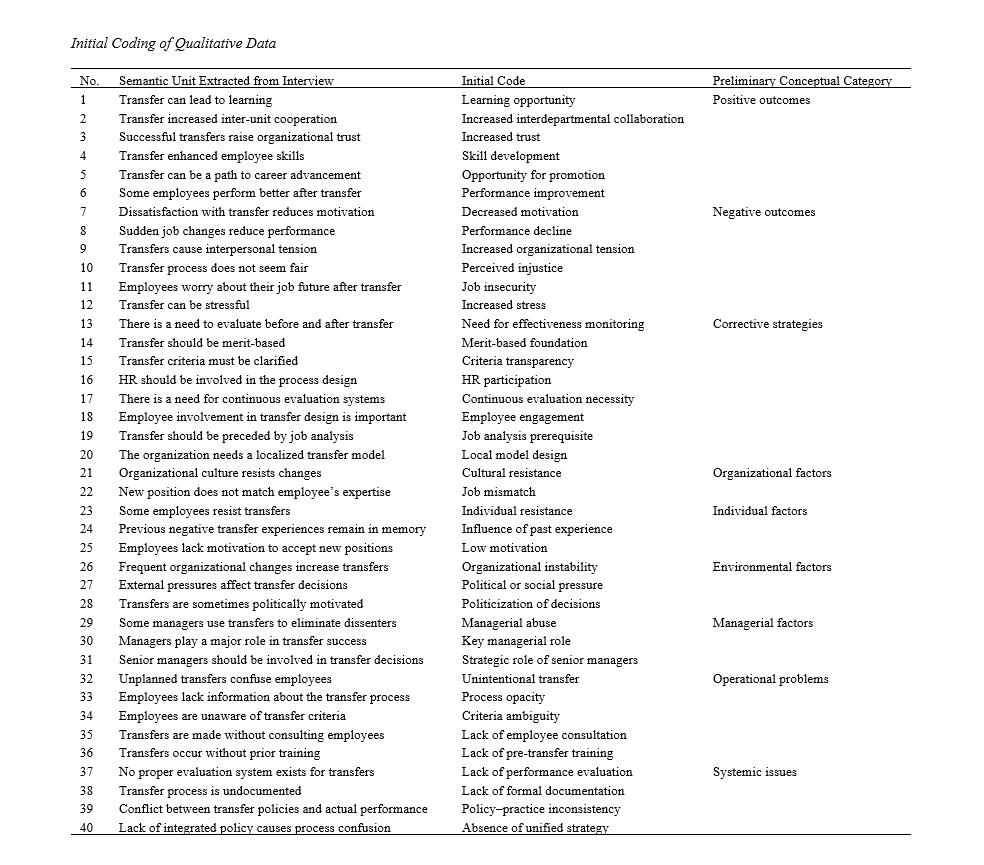Designing a Comprehensive Model for Human Resource Transfer in the Tax Affairs Organizations of Tehran
Keywords:
Comprehensive transfer model design, human resource management, service organizationsAbstract
The objective of this study is to design a comprehensive model for the effective management of employee transfer processes, with a focus on identifying the outcomes, challenges, and influencing factors in public sector organizations, particularly the Tax Affairs Organization in Tehran. This study is developmental in its objective and adopts a qualitative–analytical approach in methodology. In the qualitative phase, using thematic analysis and a semi-structured interview tool, the perspectives and experiences of 15 individuals—including managers, human resource specialists, and experienced employees—were examined. The qualitative data were analyzed through initial coding, the extraction of sub-themes, and the identification of final themes. In the quantitative phase, to test causal relationships among the identified variables, a questionnaire tool was employed along with statistical tests of correlation and modeling techniques. The findings of the study led to the identification of eight core themes, including the positive and negative impacts of transfer, corrective strategies, organizational, individual, environmental, and managerial factors, and systemic and implementation-related issues. These findings revealed that if employee transfers are purposefully designed and based on meritocracy, they can lead to skill development, increased trust, and improved performance. In contrast, in the absence of supportive structures, transfers may result in diminished motivation, heightened stress, perceived injustice, and reduced efficiency. Accordingly, the proposed model of this research can serve as a roadmap for reforming human resource policies within public sector organizations.
References
Aleem, M., & Bowra, Z. A. (2020). Role of training & development on employee relocation and organizational commitment in the banking sector of Pakistan. Review of Economics and Development Studies, 6(3), 639-650. https://doi.org/10.47067/reads.v6i3.252
Alrakhawi, H. A., Elqassas, R., Elsobeihi, M. M., Habil, B., Abunasser, B. S., & Abu-Naser, S. S. (2024). Transforming Human Resource Management: The Impact of Artificial Intelligence on Recruitment and Beyond. https://philpapers.org/rec/ALRTHR
Amirkabiri, A., Taghvi Nejad, S. K., & Khademi, A. A. (2018). Investigating the Impact of Empowerment on Employees' Intent to Leave with Job Satisfaction as a Mediating Variable (Case Study: Tax Affairs Department of Southern Tehran). Tax Research Journal, 5, 35-106. https://www.google.com/url?sa=t&source=web&rct=j&opi=89978449&url=https://www.sid.ir/paper/511514/en&ved=2ahUKEwjjnKDskdaOAxUZcKQEHQQ4EhAQFnoECBUQAQ&usg=AOvVaw08qdpnSv232Q4UFurf2xjo
Bai, Y., Zhou, J., & He, W. (2023). How Employee Job Burnout, Work engagement, and turnover intention related to career plateau during the epidemic. Social Sciences, 2(394), 1-16. https://doi.org/10.3390/socsci12070394
Bergsten, E. L., Haapakangas, A., Larsson, J., Jahncke, H., & Hallman, D. (2021). Effects of relocation to activity-based workplaces on perceived productivity: Importance of change-oriented leadership. Applied Ergonomics, 93, 1-7. https://doi.org/10.1016/j.apergo.2020.103348
Chao, S., Johanson, M., & Guchait, P. (2019). Employees intent to leave: A Comparison of determinants of intent to leave versus intent to stay. International Journal of Hospitality Management, 28(3), 374-381. https://doi.org/10.1016/j.ijhm.2008.10.007
Lazari, M., Alvarez, J. M., & Ruggieri, S. (2022). Predicting and explaining employee turnover intention. International Journal of Data Science and Analytics, 14, 279-292. https://doi.org/10.1007/s41060-022-00329-w
Makram Dary Mohammad, J., & Bahramzadeh, M. R. (2023). Investigating the Relationship between Internal Marketing and Employees' Intent to Move through Work Engagement, Management Coaching, and Job Satisfaction. Journal of Management Studies, 3, 1-69. https://www.google.com/url?sa=t&source=web&rct=j&opi=89978449&url=https://jsm.kavian.ac.ir/article_181433.html&ved=2ahUKEwjn08T9kdaOAxVPcKQEHdoEBxoQFnoECBQQAQ&usg=AOvVaw28ZzgOMuyeMP6TAwJ335Ub
Rastgar, A. A., & Hasani, H. (2023). Investigating the Mediating Role of Benevolent Rule-Breaking and Leader-Follower Exchange in the Impact of Ethical Leadership on Employees' Intent to Leave (Case Study: Social Security Organization of Tehran). Psychological Research in Management, 9(2), 203-223. https://www.google.com/url?sa=t&source=web&rct=j&opi=89978449&url=https://civilica.com/doc/1900306/&ved=2ahUKEwjCrIWIktaOAxWLcKQEHbuxKNoQFnoECBgQAQ&usg=AOvVaw34lr73u9p7L42W_QQNzmVO
Rolfö, L. V. (2018). Relocation to an activity-based flexible office - Design processes and outcomes. Applied Ergonomics, 73, 141-150. https://doi.org/10.1016/j.apergo.2018.05.017
Rozsa, Z., Formanek, I., & Manak, R. (2019). Determining the factors of the employees' intention to stay or leave in the Slovak's SMEs. International Journal of Entrepreneurial Knowledge, 1(2), 63-73. https://doi.org/10.37335/ijek.v7i2.94
Seyed Taqvi, M. A., Alvani, S. M., Ghorbani Zadeh, V., & Hosseini, S. S. (2019). A Model for Human Resource Development in Iran's Government Organizations with a New Public Service Approach. Scientific-Research Journal of Tomorrow's Management, 18, 1-30. https://www.google.com/url?sa=t&source=web&rct=j&opi=89978449&url=https://sid.ir/paper/401859/fa&ved=2ahUKEwiUofuTktaOAxVJUqQEHYx2B2QQFnoECBQQAQ&usg=AOvVaw3y4l8GzUjTzNGtXzk5qttQ
Shojaei, S., Sadeghi, M., & Dankoub, M. (2016). Investigating the Relationship between Authentic Leadership and Intent to Move with the Mediating Role of Organizational Bullying. Organizational Behavior Studies, 5, 17-94. https://www.google.com/url?sa=t&source=web&rct=j&opi=89978449&url=https://obs.sinaweb.net/article_20257.html&ved=2ahUKEwiFsYadktaOAxXPT6QEHWR4HNoQFnoECBgQAQ&usg=AOvVaw0nWFuombADE1lQUhj4RzRW
Sohrabmanesh, F. (2020). The Effect of Perceived Intimacy and Competencies of Colleagues on Employees' Intent to Leave (Case Study: Tax Affairs Organization of Kermanshah). Journal of Management, 5, 11-47. https://www.google.com/url?sa=t&source=web&rct=j&opi=89978449&url=https://civilica.com/doc/1122672/&ved=2ahUKEwjrivqnktaOAxXYU6QEHYrSA9cQFnoECBcQAQ&usg=AOvVaw11rNuYp4sjeCMaOYs0NHoB
Tohidi, P., & Farhadi, F. (2022). Investigating the Impact of Authentic Leadership and Job Participation on Employees' Intent to Move with Job Satisfaction as a Moderating Role (Case Study: Department of Cooperatives, Labor, and Social Welfare in Shahrekord). Journal of New Research Approaches in Management and Accounting, 6, 86-745. https://www.google.com/url?sa=t&source=web&rct=j&opi=89978449&url=https://majournal.ir/index.php/ma/article/view/1643&ved=2ahUKEwj1vLOxktaOAxWtVKQEHbYdG9MQFnoECBoQAQ&usg=AOvVaw2Gxa8owLzs9-p69_Yxu49q
Veerasamy, U., Joseph, M. S., & Parayitam, S. (2024). Green human resource management and employee green behaviour: participation and involvement, and training and development as moderators. South Asian Journal of Human Resources Management, 11(2), 277-309. https://doi.org/10.1177/23220937221144361

Downloads
Published
Submitted
Revised
Accepted
Issue
Section
License
Copyright (c) 2025 Tayyebeh Hosseini (Author); Masoud Bastami; Saman Sheikh Esmaili (Author)

This work is licensed under a Creative Commons Attribution-NonCommercial 4.0 International License.









